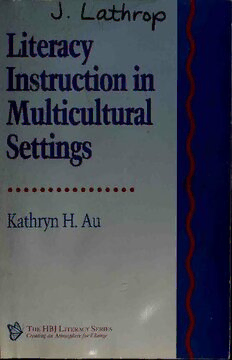Table Of ContentLaihrop
J.
literacy
Instruction in
Multicultural
Settings
Au
Kathryn H.
The HBJ Literacy Series
Creatingan AtmosphereforChange
Literacy Instruction in
Multicultural Settings
Literacy Instruction in
Multicultural Settings
Au
Kathryn H.
Kamehameha Schools
Harcourt Brace College Publishers
FortWorth Philadelphia San Diego
New York Orlando Austin San Antonio
Toronto Montreal London Sydney Tokyo
Editor-in-chief Ted Buchholz
Acquisitionseditor Jo-AnneWeaver
Developmentaleditor TracyNapper
Projecteditor SteveNorder
Productionmanager Jane Tyndall Ponceti
Seniorbookdesigner John Ritland
Literaryandillustration credits are on p. 201.
LibraryofCongressCatalogCardNumber: 92-073482
ISBN: 0-03-076847-0
Copyright© 1993 byHolt, RinehartandWinston, Inc.
Allrightsreserved. Nopartofthispublication maybe reproducedor transmittedinany
form orbyanymeans, electronicormechanical, includingphotocopy, recording, orany
information storage andretrieval system, withoutpermission inwritingfromthepublisher.
Requests forpermission tomake copies ofanypartoftheworkshouldbe mailed to:
Permissions Department, HarcourtBrace &Company, Orlando, Florida32887.
AddressforEditorialCorrespondence
HarcourtBraceCollegePublishers, 301 Commerce Street, Suite3700,
FortWorth, TX 76102.
AddressforOrders
HarcourtBrace &Company, 6277 SeaHarborDrive, Orlando, FL32887.
1-800-782-4479, or 1-800-433-0001 (in Florida)
Printed in theUnited StatesofAm§rica
5678901 090 98765
memory
in of
Ah Lun Hew Zane
Preface
LiteracyInstructioninMulticultural Settings was written to acquaint pre-
service teachers with issues they will face in teaching reading and writing
to students of diverse cultural and linguistic backgrounds. It is intended
to serve as a supplementary textbook in an introductory or other reading/
language arts methods course; it will be especially useful if the course
emphasizes a social construedvist, process, or whole language approach.
The overall theme of the book is that the reading and writing of stu-
dents of diverse backgrounds can be dramatically improved if teachers
make changes to typical school instructional situations. Familiar patterns
of instruction are contrasted with new ones, and numerous classroom
examples enable preservice teachers to visualize the new patterns and
situations.
Each chapter gives both research background and practical advice on
topics centralto theliteracyinstructionofstudentsofdiverse backgrounds.
The first five chapters provide an overviews of such broad topics as the
nature of literacy, construetivist approaches to instruction, and classroom
management. The next six chapters deal with specific topics. Two chapters
each are devoted to cultural differences and to language differences, and
two more focus on multiethnic literature and the process approach to
writing in multicultural classrooms. Each chapter begins with a statement
of major purposes, includes activities and suggested readings, and ends
with a summary. Key points in the text are boxed for emphasis.
Considerable information about the literacy instruction of students of
diverse backgrounds is currently available, but much of it is to be found
only in journal articles and in books not written specifically for teachers.
This book seeks to make this information accessible to preservice teachers
in as clear, interesting, and readable a fashion as possible. Information
about the instruction of students of African American, Asian American,
Hispanic American, and Native American backgrounds is included. This
information spans the curriculum from kindergarten through high school,
with an emphasis on elementary classrooms.
Throughout the process of writing this book, I received the help of
many colleagues. Alice Kawakami of the Pacific Region Educational Labo-
ratory read the first drafts of each chapter, spent many hours helping me
organize the flow of ideas in the book as a whole, and encouraged me to
vii
viii Preface
give the book a social conscience. Linda Vavrus of the University of Ne-
braska, Lincoln, wrote precise, detailed critiques of each chapter and of-
fered a multitude of valuable suggestions. Ronald Gallimore and Claude
Goldenberg, both of the University of California, Los Angeles, gave the
book a thorough, critical reading, taking into account a wide range of
theoretical issues and research findings on many complex and controver-
sial topics. Jacqueline Comas of the University of Florida, Gainesville; J.
David Cooper of Ball State University; Susan McMahon of the University
of Wisconsin, Madison; Ileana Seda of the Pennsylvania State University;
and Rose-Marie Weber of the State University of New York at Albany
made helpful comments on all chapters and called my attention to specific
issues that might be of interest to an audience of preservice teachers. I
am deeply grateful for the thoughts shared by all of these reviewers and
for the time taken from their already busy schedules.
I also wish to acknowledge the help of my editors at Harcourt Brace
Jovanovich College Publishers, who were always quick to respond to my
concerns. Jo-Anne Weaver provided much needed doses of enthusiasm,
and Tracy Napper showed care and insight in her attention to issues large
and small.
Finally, I wish to express my appreciation to the students, teachers,
andstaffofthe Kamehameha Elementary Education Program (KEEP),whose
talents and accomplishments have been a source of inspiration to me for
over twenty years. A special word of thanks is due to the KEEP students,
teachers, and staff at Waianae Elementary School, who have taught me
so much about the importance of a sense of community.

